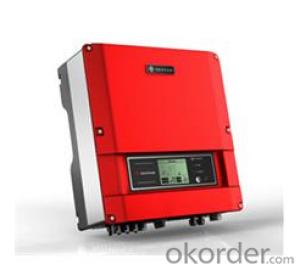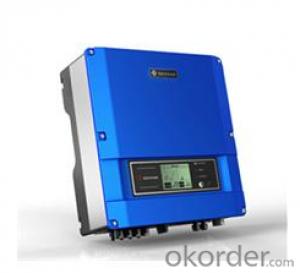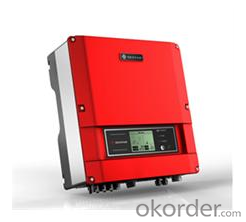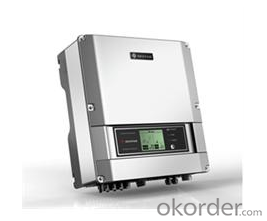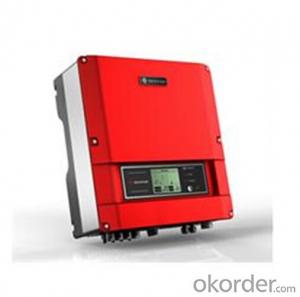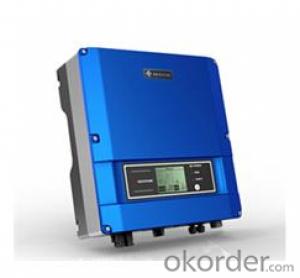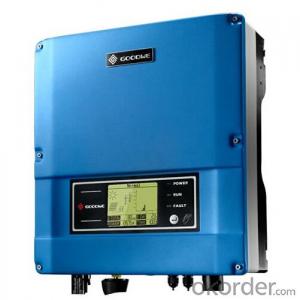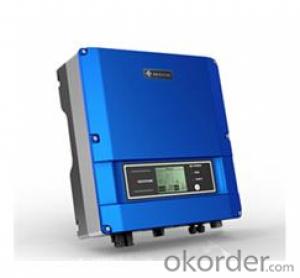1.5 Kw On Grid Solar Inverter GS3600-DS
- Loading Port:
- Shanghai
- Payment Terms:
- TT OR LC
- Min Order Qty:
- 10 unit
- Supply Capability:
- 100 unit/month
OKorder Service Pledge
OKorder Financial Service
You Might Also Like
GW3600-DS
GW3600-DS photovoltaic inverter is suitable for home rooftop photovoltaic system, designed under modern industrial concept. There are three colors for option with fashionable appearance. This model uses digital control technology to achieve Dual-lines MPP tracking. The maximum conversion efficiency is up to 97.6%, THDi is less than 1.5% and the maximum output power is 3600W. It is suitable for the photovoltaic system which open-circuit voltage is less than 580V.
| DC Input Data | Max.PV-generator power[W] | 3800 |
| Max.DC power each MPPT[W] | 2000 | |
| Max.DC voltage[V] | 580 | |
| MPPT voltage range[V] | 125~550 | |
| Turn on DC voltage[V] | 125 | |
Max.DC work current[A] | 2*10 | |
| Number of inputs/MPP trackers | 4/2(can parrallel) | |
| DC connector | MC IV Connector | |
| Self-energy consumption[W] | <5< td=""> | |
| AC Output Data | Nominal AC power[W] | 3600 |
| Max.AC power[W] | 3600 | |
| Max.output current[A] | 18 | |
| Nominal output voltage range | According to VDE-AR-N 4105, RD1663, ENEL, G59,SAA | |
| AC grid frequency | According to VDE-AR-N 4105, RD1663, ENEL, G59,SAA | |
| THDi | 〈2% | |
| Power factor | 0.95 leading...0.95 lagging | |
| AC connection | Single phase | |
| Efficiency | Max.efficiency | 97.6% |
| European efficiency | 96.5% | |
| MPPT adaptation efficiency | >99.5% | |
| Safty Equipment | Leakage current monitoring unit | Integrated |
| DC switch disconnector | Optional | |
| Islanding protection | AFD | |
| Grid monitoring | According to VDE-AR-N 4105,AS4777.1/2/3, RD1663, ENEL,G59-2 | |
| Normative Reference | EMC compliance | EN 61000-6-1,EN 61000-6-2, EN 61000-6-3,EN 61000-6-4 |
| Safety compliance | According to IEC 62109-1,AS3100 | |
| General Data | Dimensions(W*H*D) [mm] | 390*417*165 |
| Net weight [kg] | 20 | |
| Housing | For outdoor and indoor | |
| Mounting information | Wall mounting | |
| Operating temperature range | -20~60℃(up 45℃ derating) | |
| Relative humidity | 0 ~ 95% | |
| Site altitude[m] | 2000 | |
| IP protection class | IP65 | |
| Topology | Transformerless | |
| Cooling | Nature Convection | |
| Noise level[dB] | 〈25 | |
| Display | 4" LCD | |
| Communication | USB2.0;RS485(Wireless/Bluetooth optional) | |
| Standard warranty[years] | 5/10(optional) |
- Q: How does shading impact the performance of a solar inverter?
- Shading can significantly impact the performance of a solar inverter by reducing the overall energy production of the solar panels. When certain parts of the solar panel are shaded, it creates an imbalance in the current flow, resulting in a decrease in the energy output. This can lead to a decline in the overall efficiency and power generation of the solar inverter. To mitigate this issue, technologies like bypass diodes are used in solar panels to minimize the impact of shading and ensure optimal performance.
- Q: What is the role of a solar inverter in voltage support?
- The role of a solar inverter in voltage support is to convert the direct current (DC) produced by solar panels into alternating current (AC) that can be used by the electrical grid. Additionally, it helps regulate and stabilize the voltage levels, ensuring that the electricity generated from solar power is compatible with the grid's voltage requirements.
- Q: How does a solar inverter protect against power surges?
- A solar inverter protects against power surges by constantly monitoring the voltage and current levels of the solar panels and adjusting them accordingly. It has built-in surge protection devices that detect any sudden increase in voltage or current and divert the excess energy away from the solar panels, preventing damage to the system. Additionally, the inverter is equipped with advanced circuitry and protective components that can absorb and dissipate the excess energy, ensuring a stable and safe operation of the solar power system.
- Q: How does a solar inverter handle voltage regulation during load changes?
- A solar inverter handles voltage regulation during load changes by continuously monitoring the load and adjusting the inverter's output voltage accordingly. It uses various control mechanisms to maintain a stable voltage output, such as pulse width modulation (PWM) and maximum power point tracking (MPPT) algorithms. These algorithms enable the inverter to regulate its output voltage to match the load requirements, ensuring a consistent and reliable power supply.
- Q: What are the potential risks of short-circuiting a solar inverter?
- Short-circuiting a solar inverter can pose several potential risks. Firstly, it can cause damage to the inverter itself, leading to its malfunction or complete failure. Secondly, it can result in overheating of the inverter, which may increase the risk of fire or electrical hazards. Additionally, short-circuiting can disrupt the flow of electricity, potentially causing damage to other connected equipment or appliances. Lastly, it may void the warranty of the solar inverter, resulting in additional expenses for repairs or replacements. Therefore, it is crucial to take proper precautions and avoid short-circuiting the solar inverter to ensure its safe and efficient operation.
- Q: Grid-connected inverter is generally divided into photovoltaic power generation grid-connected inverter, wind power grid-connected inverter, power equipment and grid-connected inverter and other power generation equipment power generation inverter.
- The grid inverter is a current source, the output voltage is basically the grid voltage, may be slightly raised.
- Q: What is the warranty period for a solar inverter?
- The warranty period for a solar inverter typically varies depending on the manufacturer and model, but it commonly ranges from 5 to 10 years.
- Q: How does a solar inverter handle shading or partial panel obstructions?
- A solar inverter handles shading or partial panel obstructions by employing a technique called maximum power point tracking (MPPT). MPPT allows the inverter to constantly monitor the output of each individual solar panel and adjust its operating conditions to maximize power production. When shading or partial obstructions occur, the inverter intelligently redistributes the power flow to avoid any significant drop in overall system performance. This ensures that the panels operate at their optimal efficiency, even under less than ideal conditions.
- Q: What are the main components of a solar inverter?
- The main components of a solar inverter include the converter, control circuitry, filters, and the inverter output. The converter converts the direct current (DC) power generated by solar panels into alternating current (AC) power. The control circuitry regulates and manages the power conversion process. Filters ensure the output power is clean and free from any noise or interference. The inverter output delivers the AC power to the electrical grid or to power the connected devices.
- Q: What is a solar inverter?
- A solar inverter is an electronic device that converts the direct current (DC) electricity generated by solar panels into alternating current (AC) electricity, which is suitable for use in homes, businesses, and the electrical grid.
Send your message to us
1.5 Kw On Grid Solar Inverter GS3600-DS
- Loading Port:
- Shanghai
- Payment Terms:
- TT OR LC
- Min Order Qty:
- 10 unit
- Supply Capability:
- 100 unit/month
OKorder Service Pledge
OKorder Financial Service
Similar products
Hot products
Hot Searches
Related keywords
